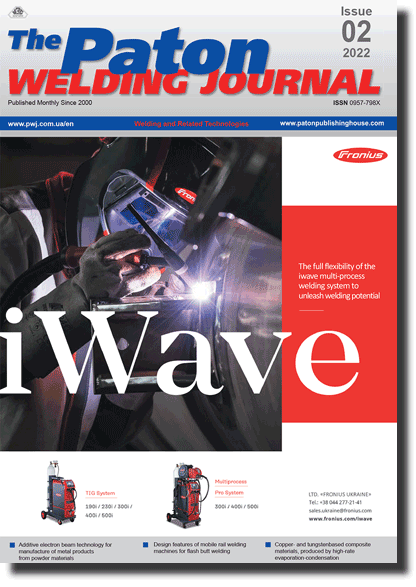| 2022 №02 (01) |
DOI of Article 10.37434/tpwj2022.02.02 |
2022 №02 (03) |

The Paton Welding Journal, 2022, #2, 11-15 pages
Influence of the composition of charge components in flux-cored strips of C–Fe–Cr–Mo alloying system on chemical and structural heterogeneity of the deposited metal
O.P. Voronchuk, O.P. Zhudra, T.V. Kaida, V.O. Kochura, L.M. Kapitanchuk, L.M. Ieremeieva
E.O. Paton Electric Welding Institute of the NASU. 11 Kazymyr Malevych Str., 03150, Kyiv, Ukraine. E-mail: voronchuk@aranei.com
Abstract
It is generally known that wear resistance of the deposited layer in the above-mentioned alloys depends on the reinforcing phase characteristics, its concentration and qualities of the matrix alloy. The methods of X-ray structural, metallographic analyses and X-ray microanalysis of metal of 500Kh30M type deposited by flux-cored strips revealed the dependence of the concentration, form, orientation, phase components and integral hardness of the carbides on the method of adding chromium as the main carbide forming element, to the charge. It is found that the maximum concentration of the carbide phase of up to 80‒90 % in the deposited layer is achieved at addition of Cr3C2 chromium carbide to the flux-cored strip charge. Complex carbide systems — (CrFe)7С3 are mainly present in the deposited metal for all the samples. Molybdenum does not form any separate carbide compounds, but it is a component in carbides of (Cr2.5Fe4.2Мо0.2)С3 type. High concentration of the carbide component leads to carbide washout, in connection with a considerable reduction of the matrix alloy. Optimal concentration of the carbide phase in metal of 500Х30М type deposited with flux-cored strip, is achieved by adding a carbide forming element — chromium to the electrode material charge in the proportion of 15‒25 % chromium carbide and 75‒85 % ferrochrome.
Keywords: flux-cored strip, chromium carbide, ferrochome, carbides, hardness, microstructure, matrix, concentration
Received: 12.11.2021
Accepted: 31.03.2022
References
1. Ryabtsev, I.A., Senchenkov, I.K., Turyk, E.V. (2015) Surfacing. Materials, technologies, mathematical modeling. Gliwice, Wydawnictwo Politechniki Śląskiej ??. https://doi.org/10.15407/tpwj2015.06.292. Ryabtsev, I.A. (2005) High-efficiency wide-layer surfacing using electrode wires and strips (Review). The Paton Welding J., 6, 36–41.
3. Pokhodnya, I.K., Shlepakov, V.N., Maksimov, S.Yu., Ryabtsev, I.A. (2010) Research and developments of the E.O. Paton Electric Welding Institute in the field of electric arc welding and surfacing using flux-cored wire (Review). The Paton Welding J., 12, 34–42.
4. Zhudra, A.P., Voronchuk, A.P. (2012) Cladding flux-cored strips (Review). The Paton Welding J., 1, 34–38.
5. Kuskov, Yu.M., Bogajchuk, I.L., Chernyak, Ya.P., Evdokimov, A.I. (2013) Electroslag surfacing of parts, made of highchrome cast iron, using cast iron shot. The Paton Welding J., 8, 46–48.
6. Kuskov, Yu.M., Evdokimov, A.I. (2014) Electroslag surfacing of wear-resistant alloyed cast irons. Uprochniayushchie Tekhnologii i Pokrytiya, 10, 21–24 [in Russian].
7. Livshits, L.S., Grinberg, N.A., Kurkumelli, E.G. (1969) Principles of alloying of deposited metal. Moscow, Mashinostroenie [in Russian].
8. Kudinov, V.D., Filimonov, B.V., Shevnov, S.A., Netesa, I.V. (1985) Surfacing with composite alloy of parts of metallurgical equipment. Avtomatich. Svarka, 5, 48–50 [in Russian].
9. Voronchuk, A.P. (2009) Effect of concentration of hard particles on gas-abrasive wear resistance of composite alloy. The Paton Welding J., 8, 43–44.
10. Zhudra, A.P., Voronchuk, A.P., Petrov, A.V., Kochura, V.O. (2012) Technology, equipment and materials for manufacture of sheet lining elements. Svarochn. Proizvodstvo, 11, 40–43 [in Russian].
11. (1973) Powder Diffraction File Search Manual. Alphabetical Listing Inorganic. Publication SMA-23, USA.
Suggested Citation
O.P. Voronchuk, O.P. Zhudra, T.V. Kaida, V.O. Kochura, L.M. Kapitanchuk, L.M. Ieremeieva (2022) Influence of the composition of charge components in flux-cored strips of C–Fe–Cr–Mo alloying system on chemical and structural heterogeneity of the deposited metal. The Paton Welding J., 02, 11-15.The cost of subscription/purchase order journals or individual articles
| Journal/Currency | Annual Set | 1 issue printed |
1 issue |
one article |
| TPWJ/USD | 384 $ | 32 $ | 26 $ | 13 $ |
| TPWJ/EUR | 348 € | 29 € | 24 € | 12 € |
| TPWJ/UAH | 7200 UAH | 600 UAH | 600 UAH | 280 UAH |
| AS/UAH | 1800 UAH | 300 UAH | 300 UAH | 150 UAH |
| AS/USD | 192 $ | 32 $ | 26 $ | 13 $ |
| AS/EUR | 180 € | 30 € | 25 € | 12 € |
| SEM/UAH | 1200 UAH | 300 UAH | 300 UAH | 150 UAH |
| SEM/USD | 128 $ | 32 $ | 26 $ | 13 $ |
| SEM/EUR | 120 € | 30 € | 25 € | 12 € |
| TDNK/UAH | 1200 UAH | 300 UAH | 300 UAH | 150 UAH |
| TDNK/USD | 128 $ | 32 $ | 26 $ | 13 $ |
| TDNK/EUR | 120 € | 30 € | 25 € | 15 € |
AS = «Automatic Welding» - 6 issues per year;
TPWJ = «PATON WELDING JOURNAL» - 12 issues per year;
SEM = «Electrometallurgy Today» - 4 issues per year;
TDNK = «Technical Diagnostics and Non-Destructive Testing» - 4 issues per year.


